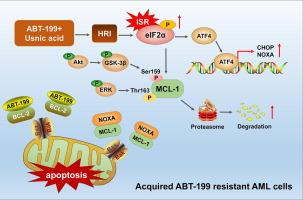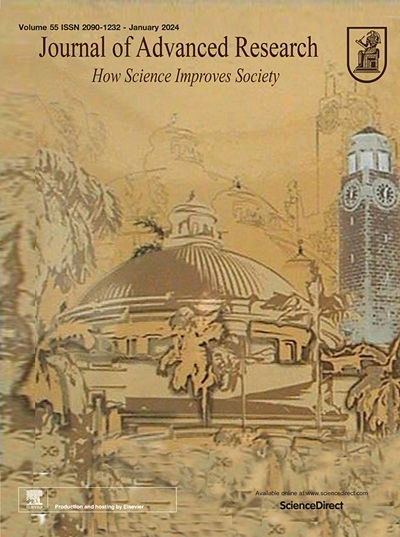菊酸诱导的综合应激反应激活可缓解急性髓性白血病对BCL-2抑制剂ABT-199的耐药性。
IF 11.4
1区 综合性期刊
Q1 MULTIDISCIPLINARY SCIENCES
引用次数: 0
摘要
简介ABT-199(venetoclax)是一种BCL-2抑制剂,对急性髓性白血病(AML)有明显疗效。然而,由于存在获得性耐药性,其作为单一疗法或与阿扎胞苷等降甲基化药物联合使用的效用值得商榷。从地衣中提取的一种二苯并呋喃类药物--乌司尼酸具有抗癌特性,可对抗白血病细胞的多药耐药性:本研究探讨了低毒性水平的烟酸是否能通过靶向综合应激反应途径,增强获得性耐药的急性髓细胞白血病细胞对ABT-199的敏感性:为了研究其对AML细胞的综合影响,我们使用了细胞活力测试、流式细胞术量化细胞凋亡、细胞周期分析和线粒体膜电位测量。RNA-seq和免疫印迹用于确定ABT-199+鸟苷酸联合作用的潜在机制:结果:在细胞毒性水平较低的情况下,鸟苷酸成功恢复了对ABT-199产生耐药性的AML细胞系对ABT-199的敏感性,并提高了ABT-199在异种移植模型中的抗白血病活性。从机理上讲,草酸与 ABT-199 的结合可通过血红素调节抑制激酶(HRI)促进综合应激反应(ISR)相关基因 ATF4、CHOP 和 NOXA 的表达,同时还能促进抗凋亡蛋白 MCL-1 的降解。ISRIB是一种阻断ISR的化合物,它能够逆转联合疗法导致的生长抑制和细胞死亡、ISR相关基因表达的增加以及MCL-1蛋白的抑制。此外,MCL-1的下调与MCL-1在丝氨酸159处的磷酸化增加以及随后被蛋白酶体破坏有关:总之,鸟苷酸通过触发综合应激反应改善了对ABT-199的化疗敏感性,从而导致MCL-1蛋白水平下降,这表明它有可能用于治疗对Bcl-2抑制剂耐药的急性髓细胞性白血病病例。本文章由计算机程序翻译,如有差异,请以英文原文为准。


Integrated stress response activation induced by usnic acid alleviates BCL-2 inhibitor ABT-199 resistance in acute myeloid leukemia
Introduction
ABT-199 (venetoclax) is a BCL-2 suppressor with pronounced effects on acute myeloid leukemia (AML). However, its usefulness as a monotherapy or in combination with hypomethylating medicines like azacitidine is debatable due to acquired resistance. Usnic acid, a dibenzofuran extracted from lichen Usnea diffracta Vain, exhibits anticancer properties and may counteract multidrug resistance in leukemia cells.
Objective
This study investigated whether usnic acid at low-cytotoxicity level could enhance sensitivity of AML cells with acquired resistance to ABT-199 by targeting the integrated stress response pathways.
Methods
To investigate the combined effects on AML cells, we used a cell viability test, flow cytometry to quantify apoptosis, cell cycle analysis, and mitochondrial membrane potential measurement. RNA-seq and immunoblot were used to determine the potential mechanisms of ABT-199 + usnic acid combination.
Results
Usnic acid, at a low cytotoxicity level, successfully restored ABT-199 sensitivity in AML cell lines that had developed ABT-199 resistance and increased ABT-199′s antileukemic activity in a xenograft model. Mechanistically, the combination of usnic acid and ABT-199 cooperated to boost the expression of the integrated stress response (ISR)-associated genes ATF4, CHOP, and NOXA through the heme-regulated inhibitor kinase (HRI), while also promoting the degradation of the anti-apoptotic protein MCL-1. ISRIB, a compound that blocks the ISR, was able to reverse the growth suppression and cell death, the increase in expression of genes related with the ISR, and the inhibition of MCL-1 protein caused by combination therapy. Additionally, the downregulation of MCL-1 was linked to an increase in MCL-1 phosphorylation at serine 159 and subsequent destruction by the proteasome.
Conclusion
In summary, usnic acid improves chemosensitivity to ABT-199 by triggering the integrated stress response, leading to decreased levels of MCL-1 protein, suggesting a potential treatment for AML cases resistant to Bcl-2 inhibitors.
求助全文
通过发布文献求助,成功后即可免费获取论文全文。
去求助
来源期刊

Journal of Advanced Research
Multidisciplinary-Multidisciplinary
CiteScore
21.60
自引率
0.90%
发文量
280
审稿时长
12 weeks
期刊介绍:
Journal of Advanced Research (J. Adv. Res.) is an applied/natural sciences, peer-reviewed journal that focuses on interdisciplinary research. The journal aims to contribute to applied research and knowledge worldwide through the publication of original and high-quality research articles in the fields of Medicine, Pharmaceutical Sciences, Dentistry, Physical Therapy, Veterinary Medicine, and Basic and Biological Sciences.
The following abstracting and indexing services cover the Journal of Advanced Research: PubMed/Medline, Essential Science Indicators, Web of Science, Scopus, PubMed Central, PubMed, Science Citation Index Expanded, Directory of Open Access Journals (DOAJ), and INSPEC.
 求助内容:
求助内容: 应助结果提醒方式:
应助结果提醒方式:


